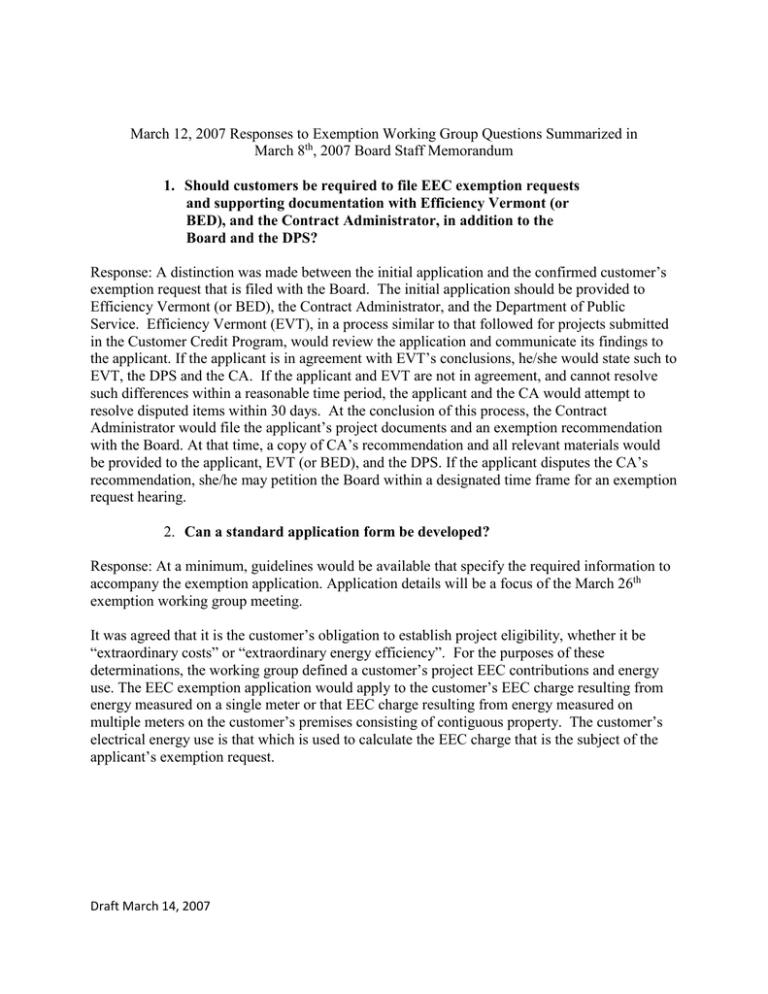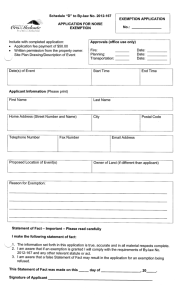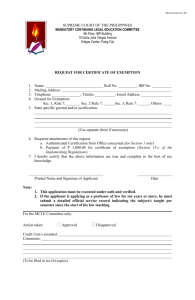March 12, 2007 Responses to Exemption Working Group Questions Summarized... March 8 , 2007 Board Staff Memorandum
advertisement

March 12, 2007 Responses to Exemption Working Group Questions Summarized in March 8th, 2007 Board Staff Memorandum 1. Should customers be required to file EEC exemption requests and supporting documentation with Efficiency Vermont (or BED), and the Contract Administrator, in addition to the Board and the DPS? Response: A distinction was made between the initial application and the confirmed customer’s exemption request that is filed with the Board. The initial application should be provided to Efficiency Vermont (or BED), the Contract Administrator, and the Department of Public Service. Efficiency Vermont (EVT), in a process similar to that followed for projects submitted in the Customer Credit Program, would review the application and communicate its findings to the applicant. If the applicant is in agreement with EVT’s conclusions, he/she would state such to EVT, the DPS and the CA. If the applicant and EVT are not in agreement, and cannot resolve such differences within a reasonable time period, the applicant and the CA would attempt to resolve disputed items within 30 days. At the conclusion of this process, the Contract Administrator would file the applicant’s project documents and an exemption recommendation with the Board. At that time, a copy of CA’s recommendation and all relevant materials would be provided to the applicant, EVT (or BED), and the DPS. If the applicant disputes the CA’s recommendation, she/he may petition the Board within a designated time frame for an exemption request hearing. 2. Can a standard application form be developed? Response: At a minimum, guidelines would be available that specify the required information to accompany the exemption application. Application details will be a focus of the March 26th exemption working group meeting. It was agreed that it is the customer’s obligation to establish project eligibility, whether it be “extraordinary costs” or “extraordinary energy efficiency”. For the purposes of these determinations, the working group defined a customer’s project EEC contributions and energy use. The EEC exemption application would apply to the customer’s EEC charge resulting from energy measured on a single meter or that EEC charge resulting from energy measured on multiple meters on the customer’s premises consisting of contiguous property. The customer’s electrical energy use is that which is used to calculate the EEC charge that is the subject of the applicant’s exemption request. Draft March 14, 2007 3. Is it necessary to allow three months for Efficiency Vermont or BED to verify project cost-effectiveness? Response: Because of the uncertainty surrounding the number of applicants, a project’s complexity, and the degree to which the applications will include sufficient project detail, three months was seen as a reasonable starting point. 4. Will site visits be required to verify project installation? If so, who will perform them? Response: At a minimum, EVT (or BED) staff or representatives would do a site visit. The DPS, CA and or Board members or Board representatives may also be involved at the initial site visit or at a later time. The intensity of the data collection effort on a site visit would be a factor of the project’s complexity and the uniqueness of the project’s underlying technology. 5. Are paper filings sufficient to consider EEC exemption requests? Response: Paper and/or electronic documents would be acceptable for the initial application request to Efficiency Vermont (or BED), the Contract Administrator (CA), and the Department of Public Service. Paper documents will be acceptable for the CA’s exemption recommendations. Board hearings may be held for contested recommendations. 6. Is two weeks sufficient time for the Board to rule on all exemption applications? What happens if the Board receives many applications? Response: Two weeks is not sufficient time for Board review. Scheduling will be a focus of the March 26th meeting. 7. Which technical standards should be used to determine what constitutes an extraordinary amount of cost-effective energy efficiency? 8. How can agreed-upon information regarding baselines be provided to customers so that the customers can determine the incremental costs of energy efficiency? 9. How does one establish baselines for custom projects for which no baselines have been previously defined? 10. How should participant measure costs be defined? Draft March 14, 2007 Response #7 - #10: A technical working subgroup composed of representatives from BED, EVT, the DPS, and IBM was formed to propose responses. John Becker of the DPS will chair the subgroup. The goal of the subgroup is to establish a timeline for proposing responses for the March 26th meeting. 11. Are there any limits to the technical assistance that EVT may provide to a customer on a particular project before that project could no longer be used to support a request for an exemption? If so, what should those limits be? Response: To be considered at a later date. 12. If exemptions are granted, what are the possible rate impacts to customers who continue to pay the EEC? Are there steps that should be taken to minimize those rate impacts? Response: To be considered at a later date. 13. Should the schedule for applying for an exemption be modified in the first year? Response: Scheduling will be a focus of the March 26th meeting. Additional issues that the exemption working group may choose to clarify: Given EVT’s possible participation in the ISO-NE’s Forward Capacity Market, may EVT claim the capacity reductions resulting from projects that are the subject of EEC exemptions? Should EVT be able to claim a project’s energy savings towards its contract goals? If so, are there any limits to this policy? Draft March 14, 2007


